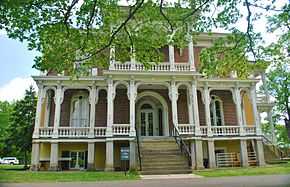Clover Bottom Mansion

The Clover Bottom Mansion is a historic mansion located at 2941 Lebanon Road in Nashville, Tennessee, United States.[1][2][3]
History
Clover Bottom Mansion occupies land on the Stones River first claimed in 1780 by John Donelson, who abandoned his homestead following an Indian attack.[4]
The Mansion was built in 1853 near Nashville's first horseracing track for Dr James and Mary Ann Saunders Hoggatt, who owned sixty slaves. It burned in 1859, and was rebuilt that same year (using some of the original walls) in the magnificent Italianate style. A similarity to nearby Two Rivers Mansion suggests that the same unknown contractor and/or architect was used. The property was the home of John McCline, whose autobiography "Slavery in the Clover Bottoms" provides a rare and detailed account of the life of a Davidson County slave prior to and during the early days of the Civil War.[1][2][3] Dr.Hoggatt died in 1863, and the home was occupied at different times during the Civil War by soldiers from both armies. Mrs. Hoggatt's brother-in-law, the former U.S. and Confederate Congressman Meredith P. Gentry, died at Clover Bottom in 1866. In the 1880s, the property was sold to Andrew Price. Mr. Price, married to Anna Gay Price, was a four term Congressman from Louisiana who had Tennessee roots. He restored the home and added several substantial outbuildings, raising thoroughbred horses on the property. [1][5] In 1918, A.F. Stanford purchased the house, and his family owned it until it was purchased by the state and converted into housing for the Tennessee School for the Blind in 1948.[1][5] It suffered a period of abandonment in the early 1980s, until an effort led by members of the Association for the Preservation of Tennessee Antiquities helped convince the state to restore it. It has been the home of the Tennessee Historical Commission, the State Historic Preservation Office, since 1994.[1]
It was listed on the National Register of Historic Places on April 3, 1975.
References
- ↑ 1.0 1.1 1.2 1.3 1.4 James A. Hoobler, A Guide to Historic Nashville, Tennessee, The History Press, 2008, pp. 10-11
- ↑ 2.0 2.1 Perky Beisel, Rob DeHart, Middle Tennessee Horse Breeding, Arcadia Publishing, 2007, p. 12
- ↑ 3.0 3.1 Michael Andrew Grissom, Southern by the Grace of God, Pelican Publishing, 1989, p. 265
- ↑ Whitsitt Edwards, Amelia (Oct 1, 1999). Nashville Interiors: 1866 To 1922. Arcadia Publishing. p. 23. Retrieved April 3, 2013.
- ↑ 5.0 5.1 Eleanor Graham, Nashville: a short history and selected buildings, Historical Commission of Metropolitan Nashville-Davidson County, 1974, p. 225